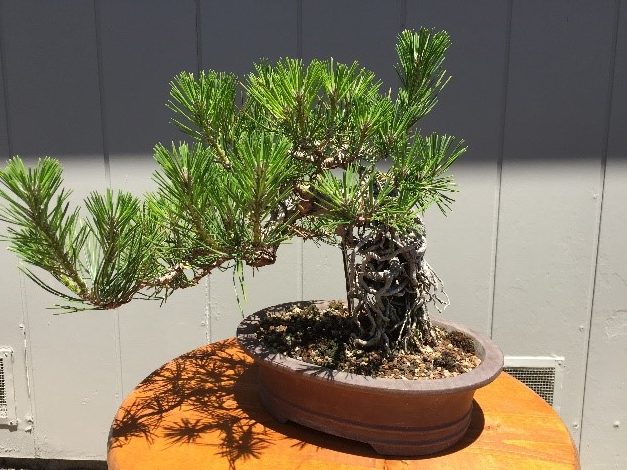These are some notes for you to think about before you get to the de-candling of your Japanese Black Pines. I have found if I de-candle between June 1 and June 10, I get good sized needles that match my size trees. These are Chyhin size trees, say 8” to 18” tall.
These first photos show typical candles on my pines. The left one is actually a stunted candle which came out normal in the spring, but because of a lack of water actually shut down and stopped growing. I am trying to revive it. The right hand one is more normal growth for a vigorous candle.
De-candling is a refinement technique on multiple flush pines only. JBP and Japanese Red Pines are the only pines we can do this on because they are so vigorous. Shore pines, Limber pines, Ponderosa and most other pines are single flush pines and are not vigorous enough to withstand this kind of treatment and respond in the same way.
Taking off the candles, in a sense, re-sets the tree back to the beginning of the growing season. If you cut candles earlier than June 1 the new set of candles have longer to grow through the summer and will be bigger and longer. If you wait and cut the candles off in July or later the new candles will have less time to grow in the summer and will be shorter when they mature.
De-candling is only used when you are trying to grow shorter needles and produce tighter and denser foliage. If you want bigger trunks or longer branches – don’t cut the candles!

These are candles on a pine in development. I will not be cutting these.


This exposed root pine was weak last year and was transplanted this spring. There are no new growth that has come out this year, but the yellow color is now a barker green. I will not do anything except water and fertilize this the rest of the growing season.


This exposed root pine has grown well and normal this spring. It has been fertilized well up until a few weeks ago when I stopped all fertilizer. No more fertilizer until mid-Fall. I will cut the candles on this the first week of June. The needles have opened up and begun to harden off. There is no further growth or extension of the candle going to happen. If left alone the needles will continue to lengthen but the candle will not lengthen much if at all.
I will cut all candles on the same day and each will be cut to about 2 mm into this year’s growth.
This is the typical technique of cutting candles. Within a few weeks there will be small rice-like buds happening at each cut site. If there is enough vigor there may even be needle buds activated further back on each stem or smaller buds further back in will begin to grow.
This is one of two times during the year you can add some wire as needed and reposition your shoots. Just be careful not to damage any interior buds.

This tree has long candles at the top of the tree and very little growth on the lower branches. In this case it is alright to de-candle the top and not cut the lower branches. This will begin to balance the growth throughout the tree and it will be more uniform top to bottom next year. Cutting the top this year will encourage growth on the bottom for the tree this year.
Cutting back vigorous growth on Black Pines at this time of year is a way to use that vigorous growth to start a second round of growth that will be smaller and denser. When that density and compactness grows out for the rest of the year without any further pinching or cut back it will be necessary to thin out that growth when the end of the growing season has passed. The next major work will be about October or November.
Pines look best when shown in mid-winter when all growth is fresh and healthy from the late season growth.
I hope this gets you to thinking about working on your pines in the next few weeks. If you have any questions I am available to talk. If you want to post photos of your trees I am sure we would all like to see what you are doing.
Stay safe and stay sane. Michael





















